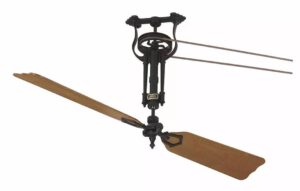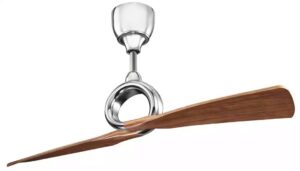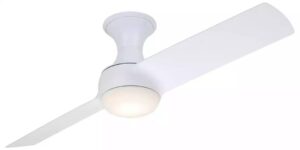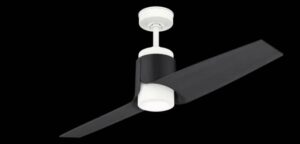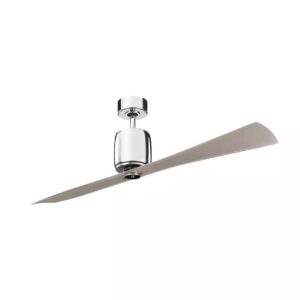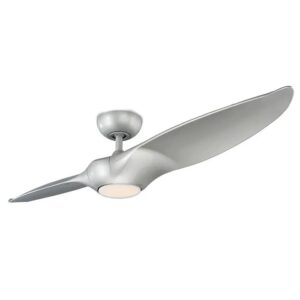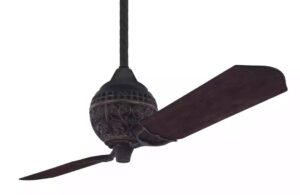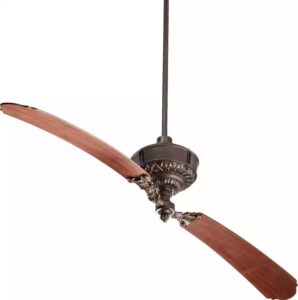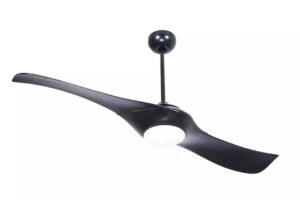Looking for the best two bladed ceiling fan? You are at the right place! We looked at dozens of retailers and countless ceiling fans. We distilled the list down to the best two bladed ceiling fans for your home or outdoor area.
We added a variety of two bladed fans to our list. Some are indoor only while others can be used outdoors. Some have smart home technology and can pair with your phone or alexa/google assistant. There is a fan for everyone in this list. We hope you find it informative.
The Fanimation Brewmaster Long Neck Motor in Black with motor size FDK2100 is your go-to for various options to customize your décor style with its detachable reversible oak/walnut blades.
The two-blade appliance is versatile in its ability to accept universal light kits as you can purchase with or without a light and choose from various light fixtures. It uses 110 volt electricity. The fan runs smoothly and quietly without wobbling and can run for 24 hours a day.
It can be used indoor and outdoor in dry or damp areas but should not be exposed to rain directly. Fanimation sure made a masterpiece with this one and upheld their reputation for producing unique but functional belt-drive fans.
The Kichler Link in Polished Nickel is a must-buy if you are looking to save 5% to 15% on your cooling bills (AC) without compromising quality and sleekness. It uses 120 volt electricity.
The DC walnut, non-reversible two-blade fan is a shy and sophisticated one as it’s for indoor use only. It’s unique ocular center adds a contemporary yet futuristic technology style to it.
Just like the Fanimation counterpart, the fan runs smooth and quiet. It can run for 24 hours a day for years on end without you worrying about its motor burning out. Its efficiency at 186 CFM/Watt is far above average with performance dependent on the room size, ceiling height, type of blade and climate.
The Link ceiling fan has two blades and a 54” blade span. The motor can run at 6 different speeds giving room for choice and speed variety.
The Link includes a remote control allowing for control at the tip of your fingers. It has a 3.13 MPH wind-speed factor and an airflow ranging from 5126 to 5780 CFM.
The Kichler Link in Polished Nickel is top-ranking in finesse, quality and durability
The Emerson 54″ Duo in Satin White is sleek and would fit into any modern home. It uses simple and minimal hardware. It is the right fit for lower ceiling fan applications.
It include a downlight feature with its integrated dimmable LED light kit in shatter-resistant Opal.
The Emerson 54″ Duo ceiling fan has an efficiency level of 77 CFM/Watt, giving you the opportunity to raise your thermostat higher and in turn reducing energy costs.
The Emerson 54” ceiling fan includes a reverse function. It has two blades with a total blade span of 54”. The motor can run at 6 different speeds so you can choose the perfect setting. It has a 2.74 MPH wind-speed factor and a 5062 CFM airflow.
This beauty with an impressive glass finish is rated for indoor use only.
The Casablanca Aya 54″ Indoor/Outdoor Ceiling Fan in Porcelain White is a multi-tasker as it functions as a dual-area fan to be used both indoor and outdoor. It has a multi-position mounting system that allows for standard, low or angled mounting.
It has reversible blades that aid cross air circulation and wind or chill breeze. It can be used in all rooms but serves porches, bathrooms, sunrooms and patios excellently with an 18W max Watt.
The Casablanca Aya ceiling fan has two blades, each having a 15 degree blade pitch. Each blade is 6” in length. The motor can run at 6 different speeds leaving room to choose the perfect setting. It includes 1 bulb that is dimmable but produces enough light to fill the room.
The fan is highly recommended because it is sturdy, quiet and eco-friendly. It is resistant to rust due to its plastic material. It would excellently serve your patios, sunrooms, porches, bathrooms a lifetime.
Looking to cut down on A/C usage? This is a great fit.
The two-bladed 60” Ferron fan is a contemporary fan for indoor use only. The 60” Ferron is appealing with its minimalist and sassy touch. It has a DC ceiling motor that saves you 75% electricity than most typical fans with AC motors.
The 60” Ferron is an average fan with a wind speed factor of 2.36 MPH. It includes two blades, with at total blade span of 60”. The fan has a 6785 CFM airflow and 14 degree pitch. It includes a reverse function allowing for cross air circulation.
It gives light cool breeze, making it suitable for babies and people with respiratory or pneumatic conditions.
It runs smoothly and quietly without wobbling. It can run for several hours per day. It is durable for years without you worrying about the motor burning out.
If you’re looking to save money, add a minimalist look to your décor or if you have health conditions that prevents you from very chilly or stuffy areas, then the Kichler 60″ Ferron in Polished Nickel is the right fit.
The Morpheus 60″ is an innovative bombshell, and the tech-savvy ones will definitely love it. Control is at the palm of your hands. Whether 5ft or 5miles away as you can connect it to your smart home tech including Google Assistant, Samsung Smart Things, Ecobee and Amazon Alexa.
You can control the fan speed of this product. It allows for the free exclusive modern forms app download and sync to perform a range of impressive and superb activities.
The Morpheus 60” is a two-blade fan having a 13 degree blade pitch each at 60cm width. It is compatible with a 120 volts integrated LED bulb. It has a 2.36 MPH wind-speed factor and airflow metric of 6785 CFM.
It is a dual-area fan as it can function both indoor and outdoor. Morpheus 60” is a sleek cutting edge two- or three-blade design made with incredibly efficient and completely silent DC motors. They are up to 70% more efficient than traditional fans.
Are you a tech-savvy addict? Do you love to be in control? Do you like the idea of variety in a futuristic and innovative piece? If yes – You should get hold of the Modern Forms Morpheus 60” in Indoor/Outdoor Ceiling Fan in Automotive Silver.
The Hunter 60″ 1886 Limited Edition in Midas Black is a stunner with a 60” blade span at 14 degree blade pitch. It is a two-blade ceiling fan rated for indoor use only and accepts universal lights kits.
Hunter 60” 1886 cannot be flush mounted but includes a 12” downrod and uses 110 Volt electricity. It has variety and option added to it as it comes in Distressed Dark Cherry Basswood, Canned Wood Blades and finished blades.
The intricate sand-cast motor housing and old-fashioned decorative rope downrod sleeve reflects Hunter’s ability to pay attention to detail. The super efficient and quiet WhisperWind 172mm x 20mm Motor aids the movement of the two perfectly balanced carved woods allowing for exceptional air movement for years on end.
The motor can run at 4 different speed. It includes two blades each with a 60” blade span and lead-wire length that runs to 80”. The Hunter 60” 1886 has a 3.12 MPH wind-speed factor and 6919 CFM airflow.
If you are an admirer of the authentic and consistent turn of the century design, you cannot get any closer than 1886 Limited Edition. The Hunter 60” 1886 requires a minimum of 9 feet ceiling height.
The Hunter 60” 1886 fan will allow you to raise your thermostat by several degrees thereby saving you additional money on your cooling bills especially for AC users.
The Quorum Turner in Oiled Bronze is a transitional 2-blade ceiling fan for indoor use only. It features a 153mm x20mm – 14 pole direct drive motor with a 16 degree blade pitch and operated by a 4 speed wall control.
Quorum Turner Ceiling Fan Model 28682-86 comes in a Distressed Vintage Walnut Blade color with finished blades inclusive. It uses a 110 volt electricity and a 4” Downrod.
Quorum Turner has a sleek and royal finish to its house to ceiling blades with a 68” and 16 degree blade span and blade pitch respectively. It contains an Adapter to aid Flushmount capability.
It has a 2.05 MPH wind-speed factor and 5696 CPM airflow. Its lead-wire length runs to 80”.
Performance varies, depending on application factors such as ceiling height, room size, blade selection type and climate. Due to its low wind-speed factor and large blades, Quorum Turner produces a very light breeze.
The design enables the breeze to be spread over a larger area making the concentration of the airflow lesser than that of normal size fans.
Progress 56″ Spades in Polished Chrome is light weight and ABS composite two-blade contemporary design. It is built for durability and great performance.
It features a dual mount system, an energy saving DC motor, and a fully functional remote control with batteries. This design allows for reversibility of the fan from remote control to aid cross air circulation.
The motor can run at 6 different speeds so you can choose the perfect setting. Each of the two blades has a 56” blade span, a 22 degree blade pitch and an 80” lead-wire length. It has wind-speed factor of 3.43 MPH and a 6746 CFM airflow.
Spades features modern styling and is an ideal indoor ceiling to be used in living rooms, bedrooms and bonus rooms. It is ideal in a room size ranging from 226- to 400- square feet and flexible to install.
Spades is an energy-saving fan powered by an over-efficient DC Motor (EcoMotor) and uses 110 volt electricity to power. The blades come in a Black ABS Composite colour.
The Progress 56” Spades in Polishes Chrome will allow you to raise your thermostat by several degrees allowing fur cost cutting on cooling bills for AC users.
Craftmade Vogue II in Flat Black is a stylish appliance. It comes with a single globe light fixture with frosted white glass, and has an 18 degree blade pitch and 54” blade span. It has a futuristic side to it with a unique 2-blade design. It has a catchy design with intelligent dual controls wall remote and a robust 3-speed motor.
It has a variety of options including lighting a room with its integrated frost white halogen light kit or use of the fan without light. It features a blank light lens cover and comes in two modern finishes – the Flat Black with Flat Black Patches or the Titanium with Titanium Blades.
The two-bladed ceiling fan includes wall control and a 1-50 Watt JD Halogen Bulb downlight. The motor runs at 3 different speeds. The wind-speed factor is 3.2 MPH and Airflow is 5904 CFM.
Craftmade Vogue II in Flat Black has a bottom cap for installation with or without light fixture and a AC Motor size 172mm x 20mm that accounts for a smooth and durable operation with a considerable amount of cooling breeze chill effect.
The Craftmade Vogue II in Flat Black ceiling fan is for indoor use only and functions effectively in a moderately-sized room. This fan will let you raise your thermostat by 1 or 2 degrees saving you about 15% on your cooling bills.
As an affiliate partner, we may earn from qualifying purchases made on these products.
Everything To Know When Buying a Two Bladed Ceiling Fan.
We have a deep love for ceiling fans and live to help others understand these products as well as we do. That is why we took the time to write a two bladed ceiling fan buyers’ guide.
As the name implies, a two bladed fan is a ceiling fan that has two blades. These blades are usually on opposite sides of the motor and rotate in tandem to create air flow.
Two bladed fans are unique in that they are particularly stylish, sleek, and minimalist. This makes them easier to install (as you have fewer blades that need to be attached to the central motor or flush mounting.
Given that there are fewer blades than a similar fan with three or four blades, a two bladed fan collects the least amount of dust because it has a reduced surface area on which dust can fall.
This is ideal for people looking to have a minimalist aesthetic and for those who have allergies and want to mitigate cleaning efforts.
Lastly, two bladed fans use slightly less energy than a multi-bladed fan, which can help you save money over time.
Two bladed or many blades…how to evaluate any ceiling fan
Buying a two bladed ceiling fan for the first time can be overwhelming. There are many options for fans and each fan has different styles, sizes, functionality, and installation steps.
Fortunately for you, we have distilled all of the key variables down into an accessible and digestible guide. You can read this guide if you want an in-depth understanding of ceiling fans or you can skim it if you only want to better understand certain aspects of the fan itself.
This includes how to select a fan to buy, the types and angles of a fan’s blades, the pros and cons of the AC and DC motors that power fans, and how to install the fan on your ceiling. If you follow this guide you can be confident that you are making a well informed buying decision.
We know all things ceiling fans and want to pass on our learnings and insights to help you.
Most importantly, we know that once you evaluate, select, and install a ceiling fan it will likely remain in place for many years to come. That is because ceiling fans can be heavy, expensive, and labor intensive to install.
Take the time to do research now before buying because the switching costs of changing your mind can be high.
Go through this evaluation check-list so that you better understand the types of motors, blades, installation units, and fans exist. We encourage you to optimize for:
- Overall quality: in particular the speed of the motor to optimize for cooling efficacy and quietness.
- Aesthetics: in particular ensure that you are happy with how the fan looks, its color, shape, and design.
- Size: select the right size fan for the room you will be placing it in. Larger rooms require larger fans to create strong air flow.
Selecting the location of a ceiling fan: Inside or Outside
Most two blade ceiling fans are used within the home. Others are for outdoor structures. Before deciding which type of fan to buy, determine where you will place it. Understanding the placement of a ceiling fan will help you select other attributes – like size, speed, and sound – that will enhance your experience with the fan.
Outdoor fans require different electrical strategies and water-proof finishes. Please keep this mind throughout the guide as we largely focus our attention and advice to those people who want to install indoor fans.
If placing the ceiling fan in an indoor room, measure the size of the room.
Bathrooms tend to be smaller than bedrooms which tend to be smaller than living rooms or kitchens.
Knowing the approximate size of the room in which the fan will be placed is important.
Larger fans are best suited to larger rooms as their blades and motors move greater volumes of air.
Ceiling Fan Size Chart
| Room (in feet) | Cubic Feet/Minute | Fan Size |
| 6′ x 6′ | 3,000 – 4,500 | Shop: 24″ to 36″ |
| 10′ x 10′ | 4,000 – 5,500 | Shop: 37″ to 48″ |
| 12′ x 12′ | 6,200 – 7,500 | Shop: 49″ to 56″ |
| 15′ x 15′ | 7,000 – 9,000 | Shop: 60″ to 72″ |
| Larger | 9,000 – 11,000 | Shop: 80″ to 99″ |
The length of the blade of the fan and the size of the room go hand in hand.
In short, if you have a large room, buy a larger fan. The bigger the fan the better.
The common sizes for ceiling fans are 36, 44 and 52 inches, with the largest having a blade wingspan of 60 inches.
Measure the height of the ceiling and allow at least 7 feet and 6 inches of space.
It is wise and safe to place your fan at least 7 feet above your flooring.
Placing a two bladed ceiling fan high up protects tall individuals from hitting their head or having their hair caught while the fan is in motion. Fans need to be installed on ceilings and these installation bases take space as well.
An installation base is adjoined to a downrod, which is a simple piece of metal that the fan is connected to and hangs from.
The average American ceiling height today is 9 feet (2.7432 meters). This means that the average room can support a fan but with a shorter downrod.
If you have average sized ceilings you can afford to install no more than 1 foot and 6 inch downrods.
How to measure downrods and base mounts
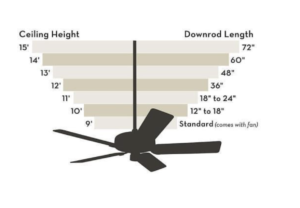
A two bladed ceiling fan is composed of fan blades, a downrod, and an installation base.
The installation base attaches to the ceiling. The downrod connects to the base. And the fan itself hangs from the downrod.
Per the measurements mentioned above, the fan must be at least 7 feet and 6 inches above the ground if you have a standard 9 foot ceiling.
There is one exception: fans placed above beds, where you will not walk, require less height.
Many people enjoy selecting the fit and finish of the downrod as these pieces of metal or plastic come in different colors, shapes, and sizes and compliment the overall fan’s aesthetic.
As a general rule, more expensive ceiling fans enable you to have longer and more customizable downrods. The downdrods tend to be longer – between 6 and 18 inches.
This is for functionality and aesthetics. Cheaper ceiling fans sometimes have very short – or almost nonexistent downrods – because the base and the fan are fused together.
Design and Look: What to Think About the fan’s general aesthetics
A hugely important aspect of a ceiling fan is what it looks like. If you see the fan while lying in bed or while in your living room you will want it to look great.
The base and downrod are not nearly as important as the blades for how a fan looks in a room.
Blades come in different cuts, lengths, seizes, finishes, colors and of course quantities.
How many blades should the fan have?
At a minimum, a ceiling fan will have two blades. This is a typical design for a two bladed fan.
A two bladed fan can be made of one long piece of metal connected at the mid-point or two distinct blades.
When you look at a fan that is turned on, the blades are hard to see. When the fan is stationary, however, the design and color of the blades will need to align with your preferences for style and decor.
Another subtle variable is at play too: the angles of those blades. If the blades are too flat, they won’t whisk through the air and create air flows. We highly advise blades with angles between 12 and 14 degrees.
Nearly all of the fans we provide you here have angles in that range for optimal air circulation and air flow efficacy.
More than a fan: how a fan provides lighting, symmetry, and aesthetic benefits.
Some people buy two bladed ceiling fans simply to cool or heat a room. Others buy two bladed ceiling fans because they can be elegant and add character to a home. Some fans have lights and others do not.
If you are going to place your fan in the center of a room – for example, your living room – you might do so at the expense of a central lighting system.
For this reason, adding lights to fans is popular. If you add lights you will want to also consider how easy it is to change the bulbs, especially if the fan is very high above your floor.
LED, Halogen, and Fluorescent lighting options are available on all fans that have integrated lighting. Many two bladed fans have a central lighting system, per this photo.
Control Your Environment: Noise and Air Flow
Fans without lights produce two types of energy outputs when they are on: noise and air-flow. Both will impact your experience with the fan. Fans with lights also produce illumination as an energy output.
Firstly, noise is a byproduct of any fan. The rotation of the blades and the motor can cause distinct sounds. Larger motors produce more power and, as a result, can generate more noise.
The good news is that noise can be mitigated.
Motors that are built from higher quality and durable screws, armature, bearings, windings, and rotors are more expensive.
Cheaper fans have motors that usually produce more noise as a byproduct.
If you want a quieter fan, buy a more expensive one. You won’t regret it.
Please pay particular attention to this when considering which type of fan you will place in different rooms in your home. If you are considering a bedroom ceiling fan, it is prudent to optimize for minimal sound.
People tend to care less about noise when a fan is in a garage or bathroom.
The second type of energy output is air-flow.
Fans can only cool rooms, they can also heat rooms and reduce air moisture.
They substitute central cooling or work in conjunction with air conditioning.
Fans do not lower air temperatures. They produce air flows and circulation which can in turn create the effect of a windchill.
The wind chill temperature is how cold people feel. The air flow, which leads to evaporative cooling (deratification), is generated by the ceiling fan.
If you are using a fan for general room cooling, you will want a fan that accelerates the heat loss from exposed skin.
Put simply, you will want a fan that generates significant air-flows point downwards and towards the center of the room.
Air Flow Deep Dive: Cubic Feet per Minute
Air flow is the volume of air that is produced by the fan.
The most common way to measure air flow is Cubic Feet per Minute (or CFM).
All of the fans we review have a CFM rating so that you can easily compare how much air that each fan productes.
The average CFM is around 5,000.
For nearly all non-industrial use-cases, like your home bedroom, kitchen, living room, or garage, a CFM of 6,000-7,000 is optimal.
At this rate you will be left feeling cooler without greatly enhancing your energy bill or having papers strewn all over the place from the powerful wind currents that larger fans produce.
You might also see a measurement similar to CFM which is air (or wind) Miles Per Hour.
Much like measuring the speed at which one drives, a fan can have its air speed measured too.
Nearly all fans produce between 3 and 5 Mile Per Hour air flows. Naturally, the higher the MPH, the stronger the air flows.
Controlling Your Fan and Your Energy Output for Efficiency
Mobile apps and the internet have changed how we communicate, manage, and control various technologies.
Two blade ceiling fans are no exception.
Ceiling fans are well suited for management by a digital switch, remote, or mobile app because you can power the fans on or off (or even alter the speed) from afar.
A connected fan is controlled via a remote control or smartphone. In contrast, less expensive and simpler fans are controlled via a manual switch.
Lastly, some ceiling fans are controlled by chords.
While chords are usually made long enough for all users to reach them, please keep in mind that this can cause discomfort or annoyance on high ceilings or fans that need to be frequently turned on or off.
If you plan on installing your fan over 9 feet above the ground, you should buy a fan that can be controlled digitally.
All ceiling fans can create air-flows bi-direactionally.
Usually a simple switch exists on the fan’s motor or external base that enables you to change the direction in which the blades rotate.
Changing the directional air propulsion is critical during the winter months.
Rather than have air convected from the center of the room for cooling, you will want air to move from the blades horizontally down through the walls.
Lateral air-flow is used for heating rooms and maintaining central warmth while reducing your energy bill.
Choosing the right ceiling fan direction
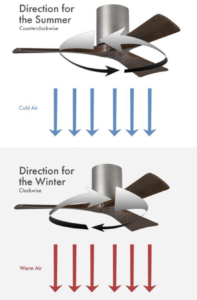
How you control your fan is correlated with how much energy your fan uses. Will you leave it running all the time? Or will you use smart logic to power it down after a certain amount of time?
We have gone above and beyond to think about fans not just as cooling mechanisms but as a tool that can help you save money while lowering your ecological footprint. These efforts will, most importantly, save you money.
Let me explain further.
When you use central cooling or air conditioners, you are physically reducing the temperature in a room.
An air conditioner sucks air into its ducts through a vent. This air cools the gas in the evaporator and as the heat is removed from the air, it is cooled. Cool air then flows into your room.
This process is energy intensive and expensive.
In contrast, a two bladed ceiling fan does not cool the room or remove heat. Rather, it moves air around which creates the feeling of cooling. Actual cooling is not occurring. Less energy out means less energy in. And in total this means a lower energy bill.
What A Fan Looks Like To You and Others
This guide provides ample information pertaining to how a ceiling fan works and things you should be aware of before buying one or many fans for your home.
What we have not discussed in great depth is how a fan looks and the importance of design aesthetics.
A fan will need to fit aesthetically into your room and, as a result, you should think about material (wood, metal, plastic), color, and design patterns. Some questions to reflect on:
- Is the room light or dark? Is it well or does it require lots of electrical light?
If your ceiling fan is going in the center of your living room, for example, you will likely want a fan with built-in lighting. This is because many living rooms have existing fixture hardware and wiring.
- Do you want a smart fan that connects with your digital applications and services (Google Home, Nest Apple Siri, Amazon Alexa)?
If you control other aspects of your home – the temperature and humidity – via smart apps, you might want to add a ceiling fan as another connected Internet of Things device. Likewise if you have high ceilings and plan to install a fan that you can’t easily reach by hand.
Smart fans can be controlled via your phone, tablet, or voice, and these controls will make turning them on or off easier.
- What color do you want the fan? What style finish do you want?
Sleek and minimalist fans have two blades. These fans, made of lightweight metal, have universal white, grey, or black finishes.
Where to buy a ceiling fan?
Ceiling fans are heavy and can be difficult to fit in a car or to transport yourself unless you have a large vehicle or flat-bed truck. Given this, it makes a lot of sense to have your fan shipped to you so that it arrives ready for home assembly.
You can self-install a ceiling fan. This work requires moderate technical skills and physical strength. This is because you will need to install not only the fan (the blades) but you will need to connect the fan’s base to the ceiling and its electrical fixture hardware and wiring.
How much do ceiling fans cost? What impacts the price of a fan?
Two bladed ceiling fans range in price from $75 on the cheap-end to over $2,000 on the high-end. There are several reasons why the range in price is so large.
A ceiling fan, made of plastic instead of more durable wood or metal, is cheaper.
Additionally, less expensive fans have weaker motors. This means that they are capable of producing less air flow or have smaller Cubic Feet per Minute scores.
More expensive fans are akin to those you would experience at a resort or high end hotel. A ceiling fan over $1,200 will likely come packed with high tech solutions built-in.
These fans will enable you to:
- Program the fan based on motion, temperature, or humidity.
- Turn the fan on or off based on preset logic or rules for maximum physical comfort.
- Enjoy very efficient and quiet DC motors that have multi-decade support and lifetime expectations.
Moreover, these pricer fans come with app based (smart phone, iPad) mobile management and remote controls.
It is common for expensive ceiling fans to come with mount options so that you can install a panel adjacent to your light switch. These wall mounts enable you to control not only the fan (on/off) but also the fan speed and direction.
Cheaper fans do not come with these in depth level of controls or sophisticated management features.
And that is ok. Simplicity might be what you crave.
Cheaper fans cool rooms as well and can be easily turned on/off with pull chains.
Less expensive fans (in the $100-$300 price point) still come with energy-efficient dimmable lightbulbs.
AC vs DC fans: Understanding a fan’s power source
Most inexpensive fans leverage AC motors.
Although AC motors are more powerful than DC motors, they typically are less efficient and are not as good at using their energy output.
This can cause additional noise (thereby making it harder to sleep if that fan is in your bedroom).
When buying a fan, please take a moment to see the Power Source listed in the fan’s essential product information that all suppliers provide. If you buy a fan with an AC motor, it will be louder.
As a result, we highly advise buying a DC powered fan if you will be sleeping near it.
AC motors are durable and longer lasting. While this might seem positive, DC motors are better (and therefore more costly).
DC motors are simpler to install into the fan’s base, have high startup power, and have a faster response time.
This means that time will be shortened from when you switch the “on” button to when the fan is accelerating to cool your room.
Although more expensive, ceiling fans with DC motors consume 70% less power which will enable you to save money over time as you pay less to power them.
Where to place the ceiling fan: voltage and flush mounting
Many people place their ceiling fans in the center of a room or above a bed. This is to maximize comfort and the impact of the fan’s air flows.
A centrally placed two bladed ceiling fan also creates room symmetry.
Voltage is the pressure from an electrical circuit’s power, and the most common electrical outlet in any home is a 110 volt. If you live in the United States, you will need to select a fan that complies with this voltage limit.
Luckily for you, nearly all off-the-shelf ceiling fans support this standard.
When installing a ceiling fan you will need to get a few things absolutely right. We have done this many times for ourselves, our family, friends, and of course our clients.
Firstly, some ceiling fans support flush mount integrations. Flush mount fans sit directly against the ceiling and point downwards. These fans are typically useful for cooling a small room.
Not all twp blade ceiling fans are flush mountable.
This means that they will hang lower from the ceiling. If you buy a fan that cannot be flush mounted, please ensure that the lower point of the fan is at least 7 feet and six inches from the ground.
Additionally, ensure that the weight bearing load of the ceiling can support the fan.
Similar to voltage, this should be routine in many homes.
But it is worth investigating because you don’t want to buy a fan just to see it unable to stay upright.
For most fans that we review and see our clients deploy, a ceiling must be able to support approximately 35 pounds of downward pressure.
Buyer’s Guide Summary: Bringing It All Together
Buying a ceiling fan for the first time does not need to be overwhelming.
Simply follow this guide to evaluate and buy the fan that fits best in your room and adds the most value in your life.
Don’t get bogged down in the details. If nothing else, pick a fan that looks great, fits well within your room, and that is priced according to your budget.
If the fan is going into your bedroom, it is worth spending a bit more for a quitter product – you won’t regret it.


